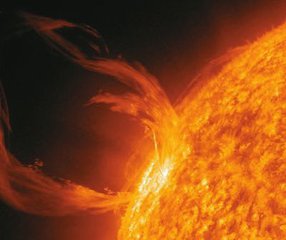Between the most experienced astronaut coming home and the strongest solar flare in 11 years,
最有经验的宇航员回家和11年来最强的太阳耀斑
the past couple of weeks have been full of record-smashing in the world of astronomy and space travel.
这两个打破天文学和太空旅行世界记录的新闻在过去几周风靡。
First, on September 2, NASA astronaut Peggy Whitson returned from the International Space Station with a bunch of new records under her belt.
第一条新闻,9月2日,宇航局宇航员佩吉·惠特森从国际空间站返回地球,她创造了很多新纪录。
Whitson had been to the ISS before, and this time, she was up there for 288 days, more than nine months!
惠特森之前去过国际空间站,这次,她在上面待了288天,超过了9个月!
It was such a long trip that she's now spent more uninterrupted time in space than any other woman in the world.
这是个长时间的旅行,她现在连续在太空待得时间比世界上任何一个其他女性都多。
And in total, she's also spent more time in space than any other American, period: a total of 665 days!
总的来说,她在太空度过的时间比任何其他美国人都要多,总共665天!
She was originally supposed to come home in June,
她原本应该在六月返回,
but she had the opportunity to stay for an extra few months and jumped on it.
但她有机会多待几个月,所以她就这么做了。
On this trip, Whitson also became the oldest woman to go to space.
惠特森也是这次太空旅行中年龄最大的女性。
She was 56 years old when she left Earth, and she celebrated her 57th birthday on the Space Station,
她离开地球时56岁,在空间站庆祝了她的57岁生日,
which sounds like a pretty awesome birthday party.
听起来是个很棒的生日派对!
Whitson has also done ten spacewalks, the most of any woman, was the first female commander of the ISS,
惠特森做了十次太空行走,是众多女性中的首位空间站女指挥官,
and is also the only woman to have taken command of the Space Station twice!
同时也是唯一一位两次指挥空间站的女性!
Besides being a record-shattering machine, Whitson is an accomplished biochemist, and did a lot of work while in orbit.
惠特森除了多次打破纪录之外,她也是一位有学问的生物化学家,在轨道上做了很多研究。
A big advantage of doing science aboard the Space Station is the microgravity, or weightlessness.
在空间站做科学试验的一个巨大优势是微重力或者无重力。
Scientists can look at systems that we understand well on Earth,
科学家们可以研究我们在地球上了解的系统,
and learn what they'll do when they're not feeling gravity pulling them to the ground.
获悉它们在没有重力作用时的反应。
Along with another astronaut, Colonel Jack Fischer,
惠特森和另一位宇航员杰克·菲舍尔上校一起做实验,
Whitson conducted experiments to learn more about what causes the vision problems many astronauts experience in microgravity.
来了解更多关于众多宇航员在微重力环境下经历的视觉问题的起因。
She also worked on projects designed to see what microgravity does to stem cells and to antibodies that could be effective in cancer treatments.
她还参与了一些项目,旨在观察微重力对干细胞的影响及能有效治疗癌症的抗体。
And just by being there, she and all the astronauts on the ISS helped NASA's ongoing effort
她在上面和国际空间站上所有的宇航员一起帮助宇航局持续努力,
to figure out what happens to our bodies when we spend a long time in space,
来弄清楚我们在太空长时间停留时身体会有何变化,
which will be especially important once we start going on longer missions, like to Mars.
这对我们更长远的任务如去火星极其重要。
Not many astronauts stay on the ISS for more than six months at a time,
没几个宇航员能一次在空间站上度过6个多月的时间,
so Whitson is giving researchers an unusual amount of data.
所以,惠特森为研究人员提供了不寻常的大量数据。
And now that she's back, she'll continue to be a scientific rockstar here on Earth,
现在,她回来了,仍是地球上的科学巨星,
at least, once she gets used to gravity again.
至少,她再次适应了重力。

Meanwhile, just after she made it home, a major solar storm kicked off!
在她回来不久,一场重要的太阳风暴开始了!
It began as a mid-sized event on September 4th,
它在9月4号开始时还是中等规模,
but quickly became an intense storm that lasted into this week.
但很快就变成了一场持续到本周的强烈风暴。
Solar storms happen when the sun releases a bunch of built-up magnetic energy,
发生太阳风暴是由于太阳释放出了聚集很久的磁能,
which causes explosions called solar flares and coronal mass ejections that can interact with the Earth's atmosphere.
导致太阳耀斑爆炸,和可以与地球大气相互作用的日冕物质抛射。
Solar flares are given a letter and number to describe how intense they are.
我们用字母和数字来描述太阳耀斑的强度。
The weakest ones are class A, followed by classes B, C, M, and X.
最弱的等级是A级,接下来依次是B级, C级, M级, and X级。
Class X solar flares are the strongest.
X级的太阳耀斑最强。
They're at least ten thousand times stronger than class A.
它们至少是A级的一万倍。
There were a few different flares, but the largest one in this storm occurred on September 6th with a magnitude of X9.3, the strongest we've seen since 2006.
这次太阳风暴有几种不同的耀斑,但最强的一次发生在9月6日,强度是X9.3级,是2006年以来最强的一次。
Solar storms can't harm humans on the ground because Earth's atmosphere protects us,
太阳风暴对地面的人类造不成伤害,因为我们有大气保护,
but storms of this magnitude can mess with satellites and power grids.
但这种强度的风暴仍会干扰卫星和电网。
Thankfully, it doesn't seem like there were any major failures this time,
庆幸的是,这次没有造成重大损失,
but we were still able to see the storm's effects!
但我们仍能看到这次风暴的影响!
After larger flares, there were short, high-frequency radio blackouts,
大规模耀斑过后,有短暂的高频无线电信号中断。
and the Northern Lights were observed as far south as North Carolina!
北极光南延,在北卡罗莱纳都能观测到!
What's unusual about this storm isn't just its intensity.
这场太阳风暴的不同寻常之处不仅在于它的强度。
It also showed up as we're moving toward a period of minimal solar activity.
也在于它出现在太阳活动最少的时期。
The sun's activity level, which includes events like solar flares, is on an 11-year cycle,
太阳的活动水平,包括太阳耀斑这样的事件,都在11年的周期之内,
where activity gets really high, then low, then high again.
这期间,太阳活动从开始的活跃,转向低迷,然后再活跃起来。
Right now, it's on its way to the lowest part of that cycle,
现在,太阳活动处于周期低迷状态,
but we still got a random, huge solar storm in the middle of that.
但这期间我们仍会遇到偶然的大规模太阳风暴。
The X9.3 solar flare was actually the largest one recorded during this entire solar cycle!
X9.3级的太阳耀斑确实是这整个太阳周期中有记录的最大一次。
It might sound weird, but a burst like this during the less active part of the cycle isn't unheard of.
这可能听起来有些奇怪,但在周期低迷期,这样的一次爆发并不是没听说过。
In the long run, the sun's activity is still going down,
从长远来看,太阳的活动仍在减弱,
but sometimes there happens to be a random strong event along the way.
但有时会有一次偶然的强烈爆发。
So it's not totally strange, just kind of surprising and special.
所以,这次爆发并不是完全陌生的,只是有点儿惊奇和特殊罢了。
And there was no major damage.
而且也没有造成重大损失。
But since we know a strong enough explosion from the sun could knock out our power grids and communications systems,
但由于我们知道,太阳的一次强烈爆炸可能会摧毁我们的电网和通讯系统,
we're still trying to get better at predicting them.
我们仍在努力能更好地预测它们。
And one way we're hoping to learn more is through the Parker Solar Probe,
我们有希望了解更多的一种方法是“帕克”太阳能探测器,
which we talked about back when the mission was first getting started.
我们在任务开始时再谈论它。
It'll launch in 2018 and investigate all sorts of mysteries about the sun.
它将于2018年发射,并对太阳的各种秘密进行调查。
Until then, we'll keep monitoring this storm as it calms down, and keep an eye out for others.
在此之前,我们将继续监测这场风暴直至它停歇,并关注其他事件。
Thanks for watching this episode of SciShow Space News!
感谢您收看本期的太空科学秀!
If you'd like to stay up to date with the latest happenings in the universe,
如果你想跟进最新的宇宙动态,
you can head over to youtube.com/scishowspace and subscribe.
可以登录youtube.com/scishowspace点击订阅。












